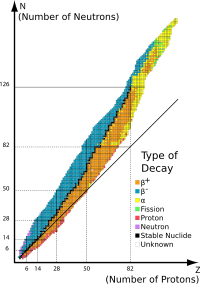
Photo from wikipedia
Multijunction solar cells based on InGaP and GaAs materials are currently the state of the art for space applications due to their high efficiencies. However, space is a hazardous environment… Click to show full abstract
Multijunction solar cells based on InGaP and GaAs materials are currently the state of the art for space applications due to their high efficiencies. However, space is a hazardous environment with different energetic particles that degrade the solar cell efficiency, hence decreasing the satellite lifetime. To gain insight in the behaviour of the solar cells under particle bombardment, we study the effect of radiation on InGaP and GaAs layers, constituent materials of III–V solar cells. By means of photoluminescence and Raman spectroscopy we investigate changes of the optical parameters in the irradiated region, and compare the results with simulations obtained with the code Stopping and Ranges of Ions in Matter. The proton ranges obtained from experiments differ considerably from the predicted by the simulations in the case of InGaP. We demonstrate that this discrepancy increases monotonously with proton energy. We discuss the possible origin of the differences in terms of electronic orbitals and bonding structure of the simulated compound, and the implications in the design of solar cells for space applications.
Journal Title: Journal of Physics D: Applied Physics
Year Published: 2020
Link to full text (if available)
Share on Social Media: Sign Up to like & get
recommendations!